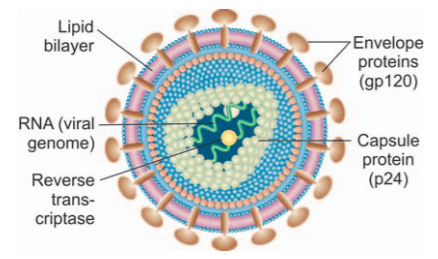- Home
- Prelims
- Mains
- Current Affairs
- Study Materials
- Test Series
 EDITORIALS & ARTICLES
EDITORIALS & ARTICLES
CCR5 Delta 32 mutation

Recently, the man referred to as the "Dusseldorf patient" became at least the third person to have been “cured of HIV” after a bone marrow transplant carrying a specific HIV-resistant mutation.
CCR5 Delta 32
- Cysteine-cysteine chemokine receptor 5 (CCR5) is a protein on the surface of white blood cells that are involved in the immune system as it acts as a receptor for chemokines.
- CCR5 is found in the cell membranes of many types of mammalian cells, including nerve cells and white blood cells.
- In humans, the CCR5 gene that encodes the CCR5 protein is located on the short (p) arm at position 21 on chromosome 3.
- Role of CCR5: The role of CCR5 is to allow entry of chemokines into the cell—chemokines are involved in signalling the body’s inflammation response to injuries.
How does the mutation work in HIV patients?
- Various mutations of the CCR5 gene are known that result in damage to the expressed receptor.
- One of the mutant forms of the gene is CCR5-delta 32, which results from the deletion of a particular sequence of 32 base pairs.
- HIV (Human Immunodeficiency Virus) mainly attacks the CD4 immune cells in the human body, thereby reducing a person’s ability to fight off secondary infections.
- The CCR5 receptors on the surface of the CD4 immune cells act as a doorway for HIV. However, the CCR5-delta 32 mutation prevents these receptors used by the HIV from forming on the surface, effectively removing the doorway.
Challenges in transplanting these receptors in HIV Patients
- Heavy load of HIV Patients - Mutation exist in very few people and nearly 38.4 million people living with HIV across the world.
- It is very difficult to find a matching donor.
- Restricted donor pool - The mutation occurs mainly among Caucasians, and restricted the donor pool further.
- High risk - Bone marrow Transplant involves high risks, especially that of the person rejecting the donated marrow.
- There is also the likelihood of the virus mutating to enter the cells through other mechanisms in such persons.
Human Immunodeficiency Virus (HIV)
- Type - HIV is a lentivirus, which is a sub-classification of the retrovirus.
- AIDS - It causes the HIV infection which over time leads to Acquired Immunodeficiency Syndrome (AIDS).
- AIDS is a deadly condition in which the affected person’s immune system fails, leading to the spread of life-threatening infections and cancers in his body.
- HIV demolishes a particular type of WBC (White Blood Cells) and the T-helper cells.
- Transmission - HIV infection can occur by the transference of blood, breast milk, vaginal fluid, semen, or pre-ejaculate.

- The cylindrical nucleoid in the mature virion is the special morphologic characteristic of HIV. In electron micrographs, the diagnostic bar-shaped nucleoid can be observed. It shows the hallmark exotic flower appearance under the electron microscope.
- In 1984, Dr. Rober C. Gallo discovered HIV.
- Human immunodeficiency virus (HIV) is a complex RNA virus of the genus Lentivirus within the Retroviridae family.
- The shape is of the virus is spherical.
- The virus is composed of a capsid core which contains the genetic material that has been surrounded by a protein envelope.
- The protein envelope has many spikes of the glycoprotein. The outer part of glycoprotein called gp120 is attached to the gp41 which is the inner part of the glycoprotein.
- The envelope of HIV also contains other proteins including some HLA antigens (Human Leucocyte Antigen).
- The genome of HIV contains two helices of RNA molecules in folded form. The enzymes reverse transcriptase is present which is responsible for the conversion of the RNA to form the DNA.
- There is another enzyme called as integrase which helps the viral genome to incorporate in the host cell.
Current treatments for HIV
- Although there are no cures for the infection at present, the disease can be managed using antiretroviral therapy.
- Anti-Retroviral Therapy - These medicines suppress the replication of the virus within the body, allowing the number of CD4 immune cells to bounce back.
- The drugs have to be taken for life because the virus continues to persist in reservoirs across the body.
- If the drugs are stopped, the virus can again start replicating and spreading.
- When the viral levels are low, the likelihood of a person transmitting the infection is also low.
- PrEP (pre-exposure prophylaxis)- Although there is no vaccine for HIV, there are Pre-exposure prophylaxis (or PrEP) medicines that can be taken by people at high risk of contracting the infection. PrEP reduces the risk of getting HIV from sex by about 99%.









 Latest News
Latest News General Studies
General Studies